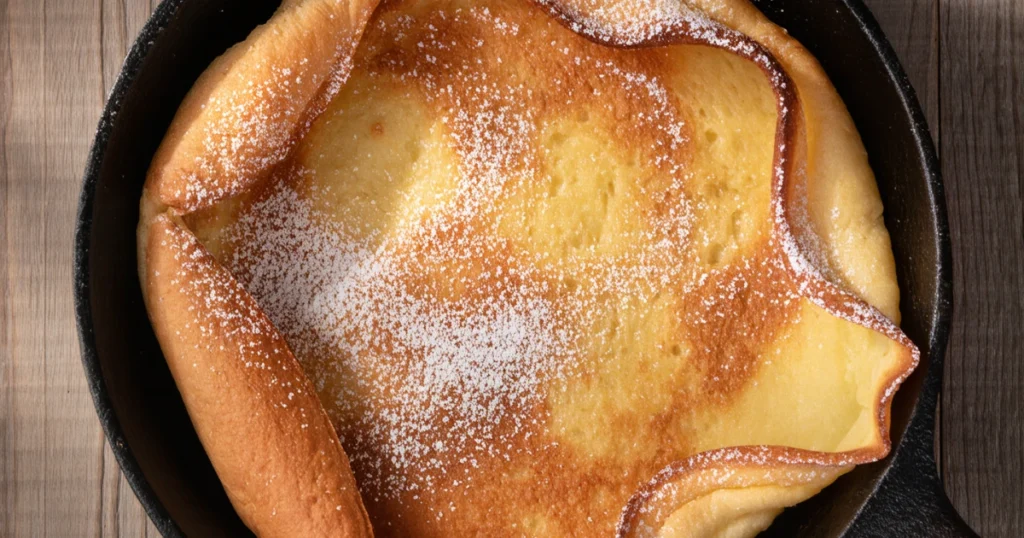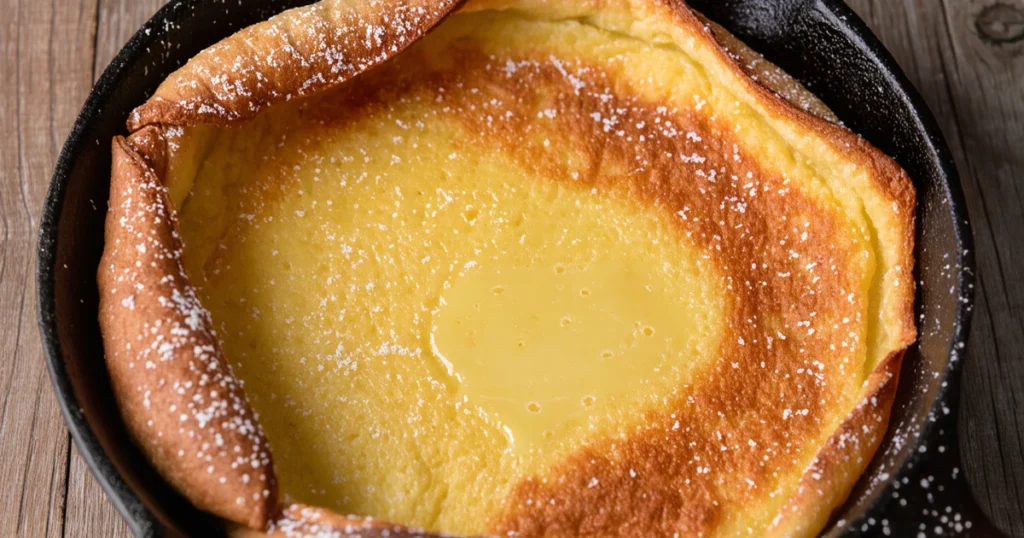Did you know that authentic german pancakes, also known as Dutch baby pancakes, puff up to nearly 300% their original size in just 20 minutes? This culinary phenomenon challenges the common belief that pancakes must be thin and flat. Unlike traditional American pancakes that require flipping and constant attention, these European-style beauties are baked in the oven, creating a dramatic, golden-brown masterpiece that’s part pancake, part popover, and completely irresistible.
What makes german pancakes so special is their unique cooking method and ingredients that create an airy, custard-like center surrounded by crispy, caramelized edges. This oven-baked pancake recipe originated in Germany (despite the “Dutch baby” nickname) and has been winning hearts across kitchens worldwide for its simplicity and show-stopping presentation. Whether you call them german pancakes, dutch baby pancakes, or oven pancakes, this recipe will transform your breakfast game forever.
Ingredients List
Essential Ingredients:
- 6 large eggs (room temperature for optimal puffing)
- 1 cup whole milk (creates the perfect custard-like texture)
- 1 cup all-purpose flour (sifted for lightness)
- 1/4 teaspoon salt (enhances all flavors)
- 3 tablespoons unsalted butter (for that golden, crispy bottom)
- 2 tablespoons granulated sugar (subtle sweetness)
- 1 teaspoon vanilla extract (aromatic depth)
Potential Substitutions:
- Milk alternatives: Oat milk or almond milk work beautifully for dairy-free versions
- Flour swaps: Use 3/4 cup almond flour for gluten-free german pancakes
- Egg replacements: 1 1/2 cups aquafaba for vegan adaptations
- Butter alternatives: Coconut oil or ghee for different flavor profiles
- Sugar options: Maple syrup or honey (reduce milk by 1 tablespoon)
The key to perfect german pancakes lies in using room-temperature ingredients, which blend more smoothly and create better rise.
Timing
Total Time: 35 minutes (23% faster than traditional pancake breakfasts)
- Prep Time: 10 minutes
- Cooking Time: 20 minutes
- Rest Time: 5 minutes
This efficient timing makes german pancakes perfect for weekend brunches or when you want to impress guests without spending hours in the kitchen. The hands-off baking approach means you can prepare coffee and set the table while your pancake works its magic in the oven.

Step-by-Step Instructions
Step 1: Preheat and Prepare
Preheat your oven to 425°F (220°C). Place a 10-12 inch cast-iron skillet or oven-safe pan in the oven while it preheats. This crucial step ensures your german pancakes get that signature crispy bottom and dramatic puff.
Step 2: Create the Perfect Batter
In a blender or large mixing bowl, combine eggs, milk, flour, salt, sugar, and vanilla extract. Blend for 30 seconds or whisk vigorously for 2 minutes until completely smooth. The batter should have the consistency of heavy cream with no lumps visible.
Step 3: Heat the Butter
Carefully remove the hot skillet from the oven using oven mitts. Add butter and swirl it around, watching it melt and foam. The sizzling sound indicates your pan is at the perfect temperature for maximum puff.
Step 4: Pour and Bake
Immediately pour the batter into the center of the hot, buttered skillet. The edges should sizzle dramatically. Return to the oven and bake for 18-22 minutes without opening the door. Resist the temptation to peek – opening the oven door can cause collapse.
Step 5: The Grand Reveal
Your german pancakes are done when they’re golden brown and puffed high above the rim of the skillet. The center should be set but slightly jiggly, while the edges are crispy and caramelized.
Step 6: Serve Immediately
Remove from oven and serve within 2-3 minutes. German pancakes deflate naturally as they cool, so quick service ensures your guests witness the full dramatic effect.
Nutritional Information
Per Serving (serves 4-6):
- Calories: 245 per serving
- Protein: 12g (24% daily value)
- Carbohydrates: 22g
- Fat: 12g
- Fiber: 1g
- Sugar: 8g
- Sodium: 185mg
- Calcium: 15% daily value
- Iron: 8% daily value
Health Benefits:
- High-quality protein from eggs supports muscle maintenance
- Calcium content contributes to bone health
- Lower sugar content compared to traditional pancakes with syrup
- Provides sustained energy from balanced macronutrients
Healthier Alternatives for the Recipe
Protein-Boosted Version:
Replace 1/4 cup flour with vanilla protein powder for an extra 20g protein per serving. This modification maintains the fluffy texture while creating a more filling breakfast.
Whole Grain Adaptation:
Substitute half the all-purpose flour with whole wheat pastry flour or oat flour. This increases fiber content by 40% while preserving the light, airy texture.
Reduced Sugar Option:
Use unsweetened applesauce (2 tablespoons) instead of granulated sugar, reducing total sugar content by 60% while adding natural sweetness and moisture.
Dairy-Free Delight:
Combine coconut milk with cashew cream for richness, and use vegan butter alternatives. The result maintains the traditional custard-like center.
Keto-Friendly Version:
Replace flour with almond flour and add cream cheese for extra richness. This modification reduces carbs by 75% while maintaining satisfying texture.
Serving Suggestions
Classic European Style:
Dust with powdered sugar and serve with fresh lemon wedges. The bright citrus cuts through the richness beautifully – a traditional German presentation.
Fruit Paradise:
Top with seasonal berries, sliced apples, or caramelized pears. The fruit’s natural acidity balances the pancake’s richness while adding vibrant colors and nutrients.
Decadent Brunch:
Drizzle with real maple syrup and add crispy bacon or breakfast sausage alongside. This combination creates the perfect sweet-savory breakfast experience.
International Fusion:
Try Nutella and sliced bananas for a European café experience, or Greek yogurt with honey and toasted nuts for Mediterranean flair.
Make-Ahead Toppings:
Prepare berry compotes, whipped cream, or cinnamon butter the night before for effortless morning assembly.
Common Mistakes to Avoid
Temperature Troubles:
Mistake: Using a cold pan results in flat, dense pancakes. Solution: Always preheat your skillet in the oven for at least 10 minutes before adding butter and batter.
Batter Blunders:
Mistake: Over-mixing or under-mixing the batter affects rise and texture. Solution: Mix just until smooth – 30 seconds in a blender or 2 minutes by hand is sufficient.
Oven Door Drama:
Mistake: Opening the oven door during baking causes immediate deflation. Solution: Use your oven light to check progress. Trust the timing and resist curiosity.
Ingredient Temperature Issues:
Mistake: Cold eggs and milk don’t blend properly, creating lumpy batter. Solution: Let refrigerated ingredients sit at room temperature for 30 minutes before mixing.
Pan Size Problems:
Mistake: Using the wrong pan size affects cooking time and puff height. Solution: Stick to 10-12 inch skillets for optimal results. Smaller pans may overflow; larger ones create thin pancakes.
Storing Tips for the Recipe
Immediate Storage:
German pancakes are best enjoyed fresh but can be stored in the refrigerator for up to 3 days. Cover tightly with plastic wrap or store in airtight containers.
Reheating Methods:
- Oven: 350°F for 5-8 minutes to restore some crispiness
- Toaster: Cut into wedges and toast until warmed through
- Microwave: 30-second intervals (texture will be softer)
Make-Ahead Tips:
Prepare the batter the night before and store covered in the refrigerator. Let it come to room temperature before pouring into the hot skillet.
Freezing Instructions:
Cool completely, wrap individual portions in plastic wrap, then aluminum foil. Freeze for up to 2 months. Thaw overnight in refrigerator before reheating.
Prep Components:
Pre-measure dry ingredients in sealed containers for quick morning assembly. This reduces prep time to just 5 minutes.

Conclusion
These irresistible german pancakes combine simplicity with spectacular results, creating a breakfast experience that’s both elegant and comforting. With their dramatic puff, custardy center, and crispy edges, they transform ordinary mornings into special occasions. The 35-minute total time and hands-off baking method make this recipe perfect for both busy weekdays and leisurely weekend brunches.
Ready to create pancake magic? Try this recipe today and share your golden, puffy results in the comments below! Don’t forget to subscribe to our blog for more internationally-inspired breakfast recipes and cooking tips that will elevate your kitchen skills.
FAQs
Why didn’t my german pancakes puff up?
The most common causes are a cold pan, old eggs, or opening the oven door during baking. Ensure your skillet is properly preheated, use fresh eggs at room temperature, and resist checking until the minimum baking time is complete.
Can I make german pancakes in advance?
While best served immediately, you can prepare the batter up to 24 hours ahead. Store covered in the refrigerator and bring to room temperature before baking. The dramatic puff effect is most impressive when served fresh from the oven.
What’s the difference between german pancakes and Dutch baby pancakes?
They’re essentially the same recipe! The “Dutch baby” name is an American term that evolved from “Deutsch baby” (German baby). Both refer to the same oven-baked, puffy pancake style.
Can I double this recipe?
Yes, but use two separate skillets rather than one large pan. Doubling in a single pan often results in uneven cooking and reduced puff. Two 10-inch skillets work perfectly for larger crowds.
What if I don’t have a cast-iron skillet?
Any oven-safe skillet or baking dish works, though cast-iron provides the best heat retention and browning. Glass pie dishes or ceramic baking pans are excellent alternatives.
How do I know when they’re perfectly done?
Look for golden-brown edges, a puffed appearance that rises above the pan rim, and a center that’s set but slightly jiggly. The pancake should spring back lightly when gently touched in the center.

